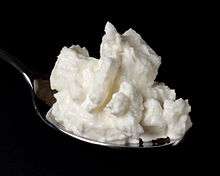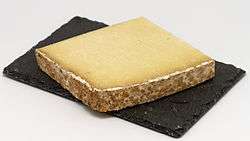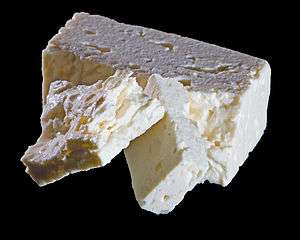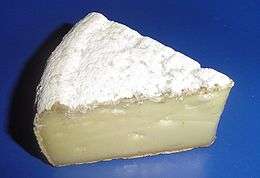List of ancient dishes
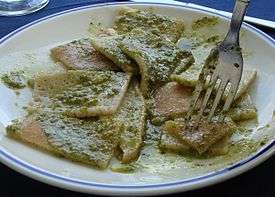
This is a list of ancient dishes, foods and beverages that have been recorded as originating during ancient history. The span of recorded history is roughly 5,000 years, beginning with Sumerian Cuneiform script, the oldest discovered form of coherent writing from the protoliterate period around the 30th century BC.[1]
Ancient history can be defined as occurring from the beginning of recorded human history to:
- The Early Middle Ages (the end of the 4th century AD)
- The fall of the Western Roman Empire in 476 AD[2][3]
- The Postclassical Era (200-600 AD and 1200–1500 AD, depending on the continent)[4][5][6][7]
Although the end date of ancient history is disputed, some Western scholars use the fall of the Western Roman Empire in 476 AD (the most used),[8][9] the closure of the Platonic Academy in 529 AD,[10] the death of the emperor Justinian I in 565 AD,[11] the coming of Islam[12] or the rise of Charlemagne[13] as the end of ancient and Classical European history. This list does not contain entries that originated after ancient history.
Beginning of recorded history to 476 AD
This section is limited to dishes that originated during the time of ancient history (the beginning of recorded human history) up to the Fall of the Western Roman Empire in 476 AD.


.jpg)
- Antipasti prepared with prosciutto and melon is "based upon ancient medical principles."[14]
- Bread[16][17][18]
- Chili pepper (hot peppers) – remains of wild peppers were found around 150 miles south of Mexico City, Mexico that date back to 7,000 BC.[22] The peppers were found in fossilized human coprolites (fossilized human feces).[22]
- Chutney[23]
- Congee[24]
- Curry[25]
- Dotorimuk
- Fatteh
- Fish sauce, see Garum
- Forcemeat[26]
- Freekeh
- Gachas
- Garum, ancient Greece (γάρος) and Roman Empire, known from before Pompeii's destruction in 79 AD[27][28]
- Gofio
- Gruel
- Ham – dry-cured ham has been produced since ancient times.[29][30][31]
- Harissa
- Jeok
- Jusselle[32]
- Kebab
- Lamb and mutton
- Liquamen, see Garum
- Maccu[33]
- Migas
- Misu karu or Misugaru[34]
- Moretum[35]
- Mulukhiyah
- Noodle – existent since at least 2,000 BC in Northwest China,[36][37] the noodle was developed independently in ancient China and ancient Rome, and remained common in both areas "through the centuries".[38]
- Olive, olive oil from Eastern Mediterranean in Bronze Age, c. 3000 BC[39][40]
- Oxygala – a dairy product in ancient Greece and Rome.[41] It was also consumed by ancient Persians.[42]
- Pane carasau
- Papadzules – a common dish in Maya cuisine that may be "one of the most ancient traditional dishes of Yucatán, Mexico.[15]
- Pilaf
- Pinole
- Placenta cake – a layered cake of pastry, cheese and honey[43][44]
- Potée
- Rice[45] – existed, but was "little-used in the ancient world" outside of Asia.[46]
- Rihaakuru
- Sauerkraut[47]
- Sausage[lower-alpha 1][49]
- Sop[52]
- Soup[lower-alpha 2]
- Sour cabbage
- Tamale[55]
- Testaroli[56][57]
- Tharida[58]
- Tofu[59]
- Torta de gazpacho
- Tracta was a kind of bread, pastry, or pancake in ancient Greece and perhaps Rome.[60]
- Ancient dishes
Beverages
- Beer is recorded in the written history of Mesopotamia and ancient Egypt and is one of the world's oldest prepared beverages.[61]
- Soy milk has been consumed in China since ancient times.[62]
- Wine consumption and production has been found through archaeological evidence as early as c. 6000 BC.[63][64]
Cereals and grains
- Amaranth grain – grain and plant bundles were found by archaeologists at the Tehuacán caves in Central Mexico that date back to around 5,500 years.[66] The grain continues to be grown in the area in contemporary times.[66]
- Barley[67]
- Bulgur (burghul) – existed Anno Domini in the Near East[41]
- Farro – may be one of the "most ancient of all ancient grains"[65]
- Hemp seed – used as a food grain in Ancient China up to the time of the Han Dynasty, at which time its use declined and then stopped.[68] This was documented as "the prevailing view" in the book Fermentations and Food Science.[68]
- Kasha (buckwheat groats) – first cultivated in China, they were later cultivated in Eastern Europe.[69] The food is still commonly used in both regions.[69]
- Millet – a staple food of ancient China, Egypt and India, before rice was used.[69]
- Wheat[67][70]
- Ancient cereals and grains
-

Millet flour
Dairy products
- Butter – documented as existent since at least 2,000 BC[72]
- Buttermilk – existed Anno Domini in India[41]
- Kumis – documented as existing in ancient Scythia[41]
- Milk[73]
- Opus lactarum – documented as existing during the ancient Roman Empire[41]
- Quark (lac concretum) – documented as existing in ancient Scythia[41]
- Schiston – "separated milk" purported to have been invented by physicians during the time of the Ancient Roman Empire and Pliny the Elder[41][74] It was prepared by boiling milk or whey along with pebbles.[74][75]
- Shrikhand – documented as existing circa 800 to 300 B.C. in ancient India[41]
- Smy – thickened milk[lower-alpha 3] documented as existent in ancient Egypt[41]
- Yogurt[77] – documented as existing in India circa 300 BC to 75 AD; referred to as "dahi"[41]
Cheeses
- Cheese[lower-alpha 4][79]
- Brindza – an ancient Romanian cheese dating to "before the time of the Romans"[80]
- Caciocavallo
- Cantal cheese – one of the oldest French cheeses, it is named after the Cantal mountain range[81]
- Castelmagno cheese[82]
- Feta – existed during the times of Homer in ancient Greece[84]
- Touloumotiri is an ancient cheese that is considered as the "forerunner to feta".[85]
- Kefalotyri – dates to the Byzantine Empire[86]
- Pecorino Romano – is one of the world's most ancient cheeses[87][88]
- Pecorino Sardo (Flore sardo) – one of the world's oldest cheeses that is believed to date back to the Bronze Age[89]
- Pecorino Siciliano[90]
- Roquefort[91][92][93]
- Tomme[94]
- Ancient cheeses
Legumes
- Mung bean – an food crop of Southwest Asia from ancient times[96]
- Soybean[97] – an ancient food crop in China, Japan and Korea[98]
Seeds
- Chia has been cultivated by the Aztecs, Mayans, Incas and "other ancient Native American cultures" for over 5,000 years.[99]
477–1500 AD
This section includes dishes, foods and beverages that originated during the time of ancient history from 477 AD to 1500 AD (prior to the Postclassical Era).
- Börek is known from 14th century Persia in a poem by Bushaq-i-Atima, and it may be far older.[100][101]
- Popcorn – an ancient food used by people of the Inca civilization.[69]
Cereals and grains
- Amaranth was used by the Aztec people (14th–16th centuries).[69]
- Quinoa – an ancient food crop[102] used by people of the Inca civilization.[103] Quinoa remains as a staple food of importance in South America.[103]
Defined as ancient, but lacking time frame

- Khanom chan – an ancient Thai dessert
- Poi is an ancient Polynesian staple food prepared using taro root.[lower-alpha 5]
Beverages
- Kombucha is an ancient beverage that originated in Asia and is used for its supposed health benefits.[lower-alpha 6]
Legumes
- Chickpea – an ancient food crop in the Ethiopian Highlands[lower-alpha 7]
Seeds
- Sesame seed is an ancient food.[107]
Likely ancient in origin
- Nattō is prepared using fermented soybeans, and has been described as likely being an ancient food.[108] Its origins have been described as unknown.[108] Nattō may have been developed independently in different areas that have the same ingredients, such as Japan, China and Korea.[108]
-
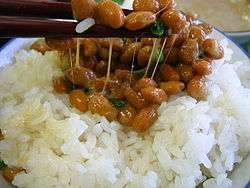
Nattō is typically consumed atop rice.
See also
- Amurca
- History of cheese – the history of cheese predates recorded history
- Neolithic founder crops – eight plant species that were domesticated by early Holocene farming communities in the Fertile Crescent region of southwest Asia, and which formed the basis of systematic agriculture in the Middle East, North Africa, India, Persia and (later) Europe
- Old World wine
- Popina – an ancient Roman wine bar, where a limited menu of simple foods (olives, bread, stews) and selection of wines of varying quality were available
- Timeline of food
Ancient cuisines
List articles
Notes
- ↑ "The origin of sausage goes back to ancient times."[48]
- ↑ "An ancient food, soup is prepared by cooking meat, fish or vegetables and the like in such fluids as water or milk; it is then consumed as a liquid."[53]
- ↑ "Smy, or thickened milk, both human and animal, is often mentioned in medical prescriptions."[76]
- ↑ "Cheese is represented in the tomb art of ancient Egypt and in Greek literature"[78]
- ↑ "In the Pacific Islands, poi, made from taro root, is an ancient food that is preserved through fermentation."[104]
- ↑ "Kombucha is an ancient food and healing product originating in Asia."[105]
- ↑ "Chickpea is an ancient food crop in the Highlands, but whether it was domesticated indigenously is debatable. Ethiopian varieties are infertile when crossed with Near Eastern varieties. This genetic incompatibility may reflect distinct ecological ..."[106]
References
- ↑ see Jemdet Nasr period, Kish tablet; see also The Origin and Development of the Cuneiform System of Writing, Samuel Noah Kramer, Thirty Nine Firsts In Recorded History, pp 381-383
- ↑ "ancient history". Collins English Dictionary. Retrieved 19 May 2016.
- ↑ "ancient history". Oxford English Dictionary. Retrieved 19 May 2016.
- ↑ Raymond, T.; Brew, H.S. (2014). Seventh Grade Social Science: For Homeschool or Extra Practice. Golgotha Press. p. pt38. ISBN 978-1-62917-337-5. Retrieved May 19, 2016.
- ↑ Harmon, J. (2013). AP World History Crash Course. Research & Education Association. p. 262. ISBN 978-0-7386-6964-9. Retrieved May 19, 2016.
- ↑ Colish, M.L. (1990). The Stoic Tradition from Antiquity to the Early Middle Ages: Stoicism in Christian Latin Thought Through the Sixth Century. Studies in the history of Christian thought. BRILL. p. 353. ISBN 978-90-04-09330-0. Retrieved May 19, 2016.
- ↑ Bedell, J.M. (2015). So, You Want to Work with the Ancient and Recent Dead?: Unearthing Careers from Paleontology to Forensic Science. Be What You Want. Aladdin/Beyond Words. p. pt22. ISBN 978-1-4814-3846-9. Retrieved May 19, 2016.
- ↑ Clare, I. S. (1906). Library of universal history: containing a record of the human race from the earliest historical period to the present time; embracing a general survey of the progress of mankind in national and social life, civil government, religion, literature, science and art. New York: Union Book. Page 1519 (cf., Ancient history, as we have already seen, ended with the fall of the Western Roman Empire; [...])
- ↑ United Center for Research and Training in History. (1973). Bulgarian historical review. Sofia: Pub. House of the Bulgarian Academy of Sciences]. Page 43. (cf. ... in the history of Europe, which marks both the end of ancient history and the beginning of the Middle Ages, is the fall of the Western Roman Empire.)
- ↑ Hadas, Moses (1950). A History of Greek Literature. Columbia University Press. p. 273. ISBN 0-231-01767-7.
- ↑ Robinson, C. A. (1951). Ancient history from prehistoric times to the death of Justinian. New York: Macmillan.
- ↑ Breasted, J. H. (1916). Ancient times, a history of the early world: an introduction to the study of ancient history and the career of early man. Boston: Ginn and Company.
- ↑ Myers, P. V. N. (1916). Ancient History. New York [etc.]: Ginn and company.
- 1 2 Wilkins, J.; Nadeau, R. (2015). A Companion to Food in the Ancient World. Blackwell Companions to the Ancient World. Wiley. p. 11. ISBN 978-1-4051-7940-9. Retrieved May 19, 2016.
- 1 2 Sterling, D. (2014). Yucatรกn: Recipes from a Culinary Expedition. The William and Bettye Nowlin Series in Art, History, and Culture of the Western Hemisphere. University of Texas Press. p. 280. ISBN 978-0-292-73581-1. Retrieved May 20, 2016.
- ↑ Flux, P. (2001). Ancient Egypt. Explore history. Pearson Education. p. 12. ISBN 978-0-435-33854-1. Retrieved May 19, 2016.
- ↑ Kaufman, C.K. (2006). Cooking in Ancient Civilizations. Daily Life Through History. Greenwood Press. p. 87. ISBN 978-0-313-33204-3. Retrieved May 19, 2016.
- ↑ Nicholson, P.T.; Shaw, I. (2000). Ancient Egyptian Materials and Technology. Cambridge University Press. p. 564. ISBN 978-0-521-45257-1. Retrieved May 19, 2016.
- ↑ Kraig, B.; Sen, C.T. (2013). Street Food Around the World: An Encyclopedia of Food and Culture. ABC-CLIO. p. 207. ISBN 978-1-59884-955-4. Retrieved May 19, 2016.
- ↑ Griffith, J.B. (2013). Knead It!: 35 Great Bread Recipes to Make at Home Today. i-5 Publishing LLC. p. 100. ISBN 978-1-62008-054-2. Retrieved May 19, 2016.
- ↑ Raichlen, S.; Fink, B. (2008). The Barbecue! Bible. Workman Pub. p. 128. ISBN 978-0-7611-4944-6. Retrieved May 19, 2016.
- 1 2 Edge, J.T. (2014). The New Encyclopedia of Southern Culture: Volume 7: Foodways. The New Encyclopedia of Southern Culture. University of North Carolina Press. p. 219. ISBN 978-1-4696-1652-0. Retrieved May 20, 2016. (subscription required)
- ↑ Aggarwal, U. (2016). Incredible Taste of Indian Vegetarian Cuisine:. First Edition. Allied Publishers Pvt. Limited. p. 200. ISBN 978-93-85926-02-0. Retrieved May 19, 2016.
- ↑ Huang, H.T. (2000). Fermentations and Food Science. Biology and biological technology. Cambridge University Press. p. 88. ISBN 978-0-521-65270-4. Retrieved May 19, 2016.
- ↑ DeWitt, D. (2014). Precious Cargo: How Foods From the Americas Changed The World. Counterpoint LLC. p. 281. ISBN 978-1-61902-388-8. Retrieved May 19, 2016.
- ↑ Hurt, J.; King, J. (2012). The Complete Idiot's Guide to Sausage Making. The Complete Idiot's Guide. DK Publishing. p. pt27. ISBN 978-1-101-57224-5. Retrieved May 19, 2016.
- ↑ Dalby, A. (2013). Food in the Ancient World from A to Z. The Ancient World from A to Z. Taylor & Francis. p. 156. ISBN 978-1-135-95422-2. Retrieved May 19, 2016.
- ↑ Pliny the Elder, Natural History 13.93. (Before 79 AD)
- ↑ V. M. Balasubramaniam, G.V.B.C.H.L.M.L. (2016). High Pressure Processing of Food. Food Engineering Series. Springer. p. 598. ISBN 978-1-4939-3234-4. Retrieved May 19, 2016.
- ↑ Dalby, A. (2013). Food in the Ancient World from A to Z. The Ancient World from A to Z. Taylor & Francis. p. 269. ISBN 978-1-135-95422-2. Retrieved May 19, 2016.
- ↑ Hui, Y.H.; Meunier-Goddik, L.; Josephsen, J.; Nip, W.K.; Stanfield, P.S. (2004). Handbook of Food and Beverage Fermentation Technology. Food Science and Technology (Marcel Dekker), Vol 134. Taylor & Francis. p. 427. ISBN 978-0-8247-5122-7. Retrieved May 19, 2016.
- ↑ The Literary Gazette and Journal of the Belles Lettres, Arts, Sciences, &c. W.A. Scripps. 1843. p. 823. Retrieved May 18, 2016.
- ↑ Helstosky, Carol (2009). Food Culture in the Mediterranean. Greenwood Publishing Group. p. 7. ISBN 0313346267.
- ↑ Kiple, K.F. (2000). The Cambridge world history of food. 2 (2000). The Cambridge world history of food. Cambridge University Press. p. 1186. ISBN 978-0-521-40215-6. Retrieved May 19, 2016.
- ↑ Dalby, A. (2013). Food in the Ancient World from A to Z. The Ancient World from A to Z. Taylor & Francis. p. 222. ISBN 978-1-135-95422-2. Retrieved May 19, 2016.
- ↑ Leslie Bilderback, CMB (2007). The Complete Idiot's Guide To Comfort Food. THE COMPLETE IDIOT'S GUIDE. DK Publishing. p. 167. ISBN 978-1-4406-2617-3. Retrieved May 19, 2016.
- ↑ Waxman, M.B. (2008). Eat Me Now!: Healthy Macrobiotic Cooking for Students and Busy People. PublishAmerica. p. pt150. ISBN 978-1-4560-4528-9. Retrieved May 19, 2016.
- ↑ Coyle, L. Patrick (1982). "The world encyclopedia of food". Facts on File. p. 427. Retrieved 20 May 2016.
- ↑ Whitehouse, R. (2016). Liguria:. Bradt Travel Guides Liguria. Bradt Travel Guides. p. 34. ISBN 978-1-78477-010-5. Retrieved May 19, 2016.
- ↑ Harper, D.; Faccioli, P. (2010). The Italian Way: Food and Social Life. University of Chicago Press. p. 153. ISBN 978-0-226-31726-7. Retrieved May 20, 2016.
- 1 2 3 4 5 6 7 8 9 10 Kurmann, Joseph A.; Rasic, J.L.; Kroger, M. (1992). Encyclopedia of Fermented Fresh Milk Products: An International Inventory of Fermented Milk, Cream, Buttermilk, Whey, and Related Products. An Avi book. Springer. p. 352. ISBN 978-0-442-00869-7. Retrieved May 19, 2016.
- ↑ Dalby, A. (2003). Food in the Ancient World from A to Z. Ancient world from A to Z. Routledge. p. 218. ISBN 978-0-415-23259-3. Retrieved May 19, 2016.
- ↑ "American Pie". American Heritage. April–May 2006. Retrieved 2009-07-04.
The Romans refined the recipe, developing a delicacy known as placenta, a sheet of fine flour topped with cheese and honey and flavored with bay leaves.
- ↑ Faas, Patrick (2005). Around the Roman Table. University of Chicago Press. p. 184-185. ISBN 0226233472.
- ↑ Proctor, H.B. (1882). Rice: its history, culture, manufacture, and food value. William Dunham. p. 9. Retrieved May 19, 2016.
- ↑ Alcock, J.P. (2006). Food in the Ancient World. Food through history. Greenwood Press. pp. 34–35. ISBN 978-0-313-33003-2. Retrieved May 19, 2016.
- ↑ Snyder, M.; Faass, N. (2009). The Everything Raw Food Recipe Book. Everything®. F+W Media. p. 295. ISBN 978-1-4405-2102-7. Retrieved May 19, 2016.
- ↑ "History of the Dry Sausage Business". Volume 61. The National Provisioner. November 29, 1919. p. 19. Retrieved 18 May 2016.
- ↑ America, United Master Butchers of (1915). American Meat Trade and Retail Butchers Journal. Wm. H. Hornidge. p. 217. Retrieved May 19, 2016.
- ↑ Jenkins, N.H. (2007). Cucina del Sole: A Celebration of Southern Italian Cooking. HarperCollins. p. 16. ISBN 978-0-06-072343-9. Retrieved May 19, 2016.
- ↑ Riley, G. (2007). The Oxford Companion to Italian Food. Oxford Companion To... Series. Oxford University Press, USA. p. 327. ISBN 978-0-19-860617-8. Retrieved May 19, 2016.
- 1 2 Schwartz, A. (1994). Soup Suppers: More Than 100 Main-Course Soups and 40 Accompaniments. HarperCollins. p. 12. ISBN 978-0-06-096948-6. Retrieved May 18, 2016.
- ↑ Coyle, L.P. (1982). The world encyclopedia of food. Facts on File. ISBN 978-0-87196-417-5. Retrieved May 19, 2016.
- ↑ Nasello, Sarah (January 10, 2015). "Try Acquacotta soup as a new recipe for the new year". The Jamestown Sun. Retrieved April 29, 2016.
- ↑ Planet, L.; Staff, Lonely Planet Publications (2012). The World's Best Street Food: Where to Find It and How to Make It. Lonely Planet Publications. p. 165. ISBN 978-1-74321-664-4. Retrieved May 19, 2016.
- ↑ White, A.; Varney, J. (2012). Philadelphia Chef's Table: Extraordinary Recipes from the City of Brotherly Love. Chef's Table. Lyons Press. p. 94. ISBN 978-0-7627-8944-3.
- ↑ Pyenson, Luke (July 30, 2013). "Genovese pesto 'pancake'? Perfetto!". The Boston Globe. Retrieved March 5, 2016. (subscription required)
- ↑ Davidson, A.; Jaine, T. (2014). The Oxford Companion to Food. Oxford Companions. OUP Oxford. p. 818. ISBN 978-0-19-104072-6. Retrieved May 19, 2016. (subscription required)
- ↑ Nguyen, A.; Caruso, M. (2012). Asian Tofu: Discover the Best, Make Your Own, and Cook It at Home. Ten Speed Press. p. 1. ISBN 978-1-60774-025-4. Retrieved May 19, 2016.
- ↑ Dalby, Andrew, Food in the Ancient World from A to Z, ISBN 1-135-95422-4, 'Pastry', p. 251
- ↑ "Beer". Britannica.com.; Michael M. Homan, Beer and Its Drinkers: An Ancient near Eastern Love Story, Near Eastern Archaeology, Vol. 67, No. 2 (Jun. 2004), pp. 84–95.
- ↑ Davidson, A.; Vannithone, S.; Jaine, T. (2014). The Oxford Companion to Food. Oxford Companions Series. Oxford University Press. p. 760. ISBN 978-0-19-967733-7. Retrieved May 19, 2016.
- ↑ Keys, David (2003-12-28). "Now that's what you call a real vintage: professor unearths 8,000-year-old wine". The Independent. Retrieved 2011-03-20.
- ↑ "Earliest Known Winery Found in Armenian Cave". news.nationalgeographic.com. Retrieved 2015-11-01.
- 1 2 3 Pittman, A.T. (2016). Everyday Whole Grains: 175 New Recipes from Amaranth to Wild Rice, Including Every Ancient Grain. Time Incorporated Books. p. 20. ISBN 978-0-8487-4744-2. Retrieved May 19, 2016.
- 1 2 Innovation, N.R.C.A.C.T. (1984). Amaranth: Modern Prospects for an Ancient Crop. BOSTID Reports. National Academy Press. p. 29. ISBN 978-0-87857-560-2. Retrieved May 20, 2016.
- 1 2 Wilson, N. (2013). Encyclopedia of Ancient Greece. Taylor & Francis. p. 27. ISBN 978-1-136-78799-7. Retrieved May 20, 2016.
- 1 2 Huang, H.T. (2000). Fermentations and Food Science. Biology and biological technology. Cambridge University Press. p. 29. ISBN 978-0-521-65270-4. Retrieved May 20, 2016.
- 1 2 3 4 5 Diamond, M. (2009). The American Vegetarian Cookbook from the Fit for Life Kitchen. Grand Central Publishing. p. 38. ISBN 978-0-446-57102-9. Retrieved May 20, 2016.
- ↑ MacDonald, N. (2008). What Did the Ancient Israelites Eat?: Diet in Biblical Times. Eerdmans Publishing Company. p. 20. ISBN 978-0-8028-6298-3. Retrieved May 19, 2016.
- 1 2 Ermatinger, J.W. (2015). The World of Ancient Rome: A Daily Life Encyclopedia [2 volumes]: A Daily Life Encyclopedia. Daily Life. ABC-CLIO. p. 307. ISBN 978-1-4408-2908-6. Retrieved May 19, 2016.
- ↑ Arnow, L.E. (1972). Food Power: A Doctor's Guide to Commonsense Nutrition. G - Reference, Information and Interdisciplinary Subjects Series. Nelson-Hall Company. p. 237. ISBN 978-0-911012-37-8. Retrieved May 19, 2016.
- ↑ Wiley, A.S. (2014). Cultures of Milk. Harvard University Press. p. 25. ISBN 978-0-674-72905-6. Retrieved May 19, 2016.
- 1 2 Thurmond, D.L. (2006). A Handbook of Food Processing in Classical Rome: For Her Bounty No Winter. Technology and change in history. Brill. p. 193. ISBN 978-90-04-15236-6. Retrieved May 19, 2016.
- ↑ Drysdale, J.J.; Hughes, R.; Dudgeon, R.E.; Russell, J.R. (1884). The British Journal of Homoeopathy. Maclachlan, Stewart, & Company. p. 244. Retrieved May 19, 2016.
- ↑ Darby, W.J.; Ghalioungui, P.; Grivetti, L. (1977). Food: The Gift of Osiris. Food: The Gift of Osiris. Academic Press. p. 775. ISBN 978-0-12-203402-2. Retrieved May 19, 2016.
- ↑ Rule, C.S. (2015). Yogurt Culture: A Global Look at How to Make, Bake, Sip, and Chill the World's Creamiest, Healthiest Food. Houghton Mifflin Harcourt. p. 353. ISBN 978-0-544-25171-7. Retrieved May 19, 2016.
- ↑ Fox, P.F. (2004). Cheese: General aspects. Cheese: Chemistry, Physics and Microbiology. General Aspects. Elsevier. p. 2. ISBN 978-0-12-263652-3. Retrieved May 19, 2016.
- ↑ Hayes, Dayle; Laudan, R. (2009). Food and Nutrition/Editorial Advisers, Dayle Hayes, Rachel Laudan. Food and Nutrition. Marshall Cavendish Reference. p. 197. ISBN 978-0-7614-7821-8. Retrieved May 19, 2016.
- ↑ Ehlers, S.; Hurt, J. (2008). The Complete Idiot's Guide to Cheeses of the World. Complete Idiot's Guide to. Alpha Books. p. 117. ISBN 978-1-59257-714-9. Retrieved May 19, 2016.
- ↑ Ehlers, S.; Hurt, J. (2008). The Complete Idiot's Guide to Cheeses of the World. Complete Idiot's Guide to. Alpha Books. p. 55. ISBN 978-1-59257-714-9. Retrieved 2016-05-19.
- ↑ Michelson, P.; Linder, L. (2010). Cheese: Exploring Taste and Tradition. Gibbs Smith. p. 114. ISBN 978-1-4236-0651-2. Retrieved May 19, 2016.
- ↑ Ehlers, S.; Hurt, J. (2008). The Complete Idiot's Guide to Cheeses of the World. Complete Idiot's Guide to. Alpha Books. p. 76. ISBN 978-1-59257-714-9. Retrieved May 19, 2016.
- ↑ Robinson, R.K.; Tamime, A.Y. (1996). Feta & Related Cheeses. Ellis Horwood Series in Food Science and Technology. Taylor & Francis. p. 49. ISBN 978-0-7476-0077-0. Retrieved May 19, 2016.
- ↑ Fox, P.F. (2012). Cheese: Chemistry, Physics and Microbiology: Volume 2 Major Cheese Groups. Springer US. p. 526. ISBN 978-1-4615-2648-3. Retrieved May 19, 2016.
- ↑ Ehlers, S.; Hurt, J. (2008). The Complete Idiot's Guide to Cheeses of the World. Complete Idiot's Guide to. Alpha Books. p. 123. ISBN 978-1-59257-714-9. Retrieved May 19, 2016.
- ↑ Donnelly, C.W. (2014). Cheese and Microbes:. ASM Press. p. 160. ISBN 978-1-55581-859-3. Retrieved May 19, 2016.
- ↑ Lawrence, L.; Lawrence, L.P. (2008). Cooking for My Family: From Catherine Pasculli's Hoboken Kitchen. iUniverse. p. 325. ISBN 978-0-595-48282-5. Retrieved May 19, 2016.
- ↑ Magazine, C.; Miller, L.; Skinner, T.; Tsai, M. (2012). Cheese For Dummies (in Spanish). Wiley. p. 177. ISBN 978-1-118-14552-4. Retrieved May 19, 2016.
- ↑ Harbutt, J. (2009). World Cheese Book. DK Publishing. p. 127. ISBN 978-0-7566-6218-9. Retrieved May 19, 2016.
- ↑ Barham, E.; Sylvander, B. (2011). Labels of Origin for Food: Local Development, Global Recognition. CABI. p. 177. ISBN 978-1-84593-377-7. Retrieved May 19, 2016.
- ↑ Kurlansky, M. (2011). Salt: A World History. Knopf Canada. p. 154. ISBN 978-0-307-36979-6. Retrieved May 19, 2016.
- ↑ Ehlers, S.; Hurt, J. (2008). The Complete Idiot's Guide to Cheeses of the World. Complete Idiot's Guide to. Alpha Books. p. 46. ISBN 978-1-59257-714-9. Retrieved May 19, 2016.
- ↑ Kessler, B. (2009). Goat Song: A Seasonal Life, A Short History of Herding, and the Art of Making Cheese. Scribner. p. 211. ISBN 978-1-4165-6099-9. Retrieved May 19, 2016.
- ↑ Harbutt, J. (1999). Cheese. Game & Fish Mastery Library. Willow Creek Press. p. 103. ISBN 978-1-57223-200-6. Retrieved May 19, 2016.
- ↑ Plant Genetic Resources Newsletter. Bioversity International. p. 25. Retrieved May 20, 2016.
- ↑ Cumo, C. (2015). Foods that Changed History: How Foods Shaped Civilization from the Ancient World to the Present: How Foods Shaped Civilization from the Ancient World to the Present. ABC-CLIO. p. 358. ISBN 978-1-4408-3537-7. Retrieved May 19, 2016.
- ↑ Bureau, C.R. (2006). The CRB Commodity Yearbook 2006. CRB Commodity Year Book. Wiley. p. 248. ISBN 978-0-470-08394-9. Retrieved May 20, 2016.
- ↑ Smith, B.E.; Plotkin, P. (2014). Idiot's Guides: The Chia Seed Diet. Idiot's guides. DK Publishing. p. pt21. ISBN 978-1-61564-531-2. Retrieved May 20, 2016.
- ↑ Marcoux, P. (2014). Cooking with Fire. Storey Publishing LLC. p. 105. ISBN 978-1-61212-158-1. Retrieved May 18, 2016.
- ↑ Davidson, Alan (2014). The Oxford Companion to Food. Oxford University Press. p. 95. ISBN 978-0-19-967733-7.
- ↑ Donoso, M.C. (2009). Water Interactions with Energy, Environment, Food and Agriculture Volume I:. p. 66. ISBN 978-1-84826-172-3. Retrieved May 20, 2016.
- 1 2 Bessinger, J.; Yablon-Brenner, T. (2009). Simple Food for Busy Families: The Whole Life Nutrition Approach. Celestial Arts. p. 80. ISBN 978-1-58761-335-7. Retrieved May 20, 2016.
- ↑ Multicultural connections. Glencoe/McGraw-Hill. 1999. p. 19. ISBN 978-0-02-827787-5. Retrieved May 20, 2016. (subscription required)
- ↑ Tietze, H. (1996). Kombucha: The Miracle Fungus. Tietze Publications. p. 4. ISBN 978-0-646-23106-8. Retrieved May 20, 2016. (subscription required)
- ↑ Barnett, T. (1999). The Emergence of Food Production in Ethiopia. BAR Series. Archaeopress. ISBN 978-0-86054-971-0. Retrieved May 20, 2016. (subscription required)
- ↑ Food Business. 1965. p. 47. Retrieved May 20, 2016. (subscription required)
- 1 2 3 D, J.D.P.; Murakhver, N. (2012). They Eat That?: A Cultural Encyclopedia of Weird and Exotic Food from Around the World. ABC-CLIO. p. 141. ISBN 978-0-313-38058-7. Retrieved May 20, 2016.
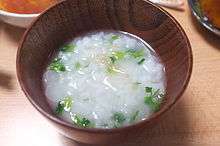

.jpg)



